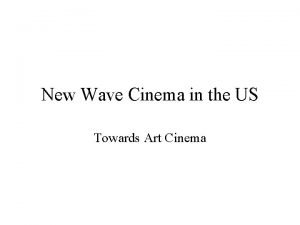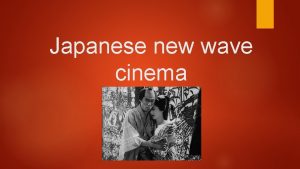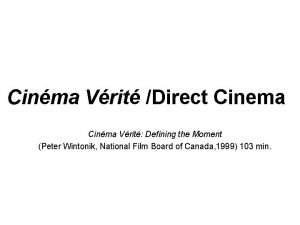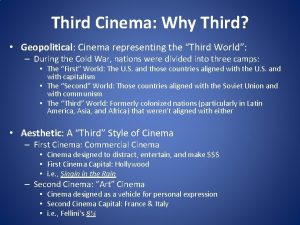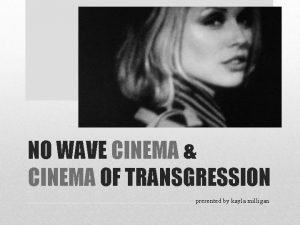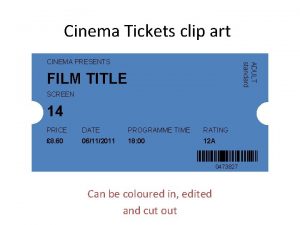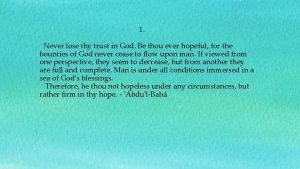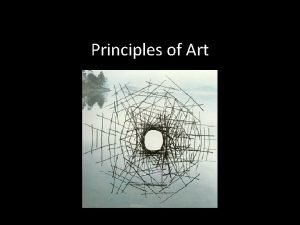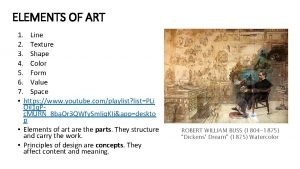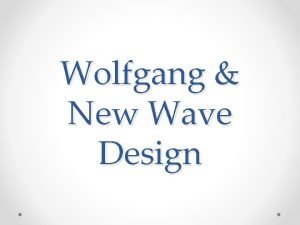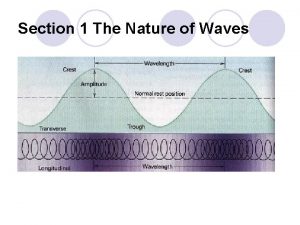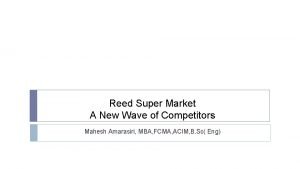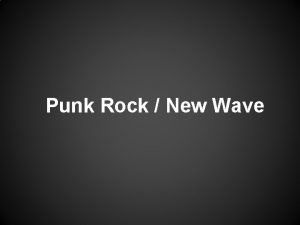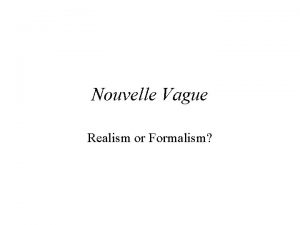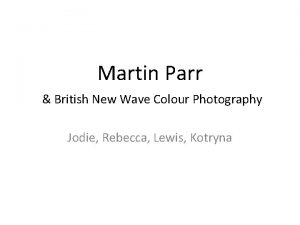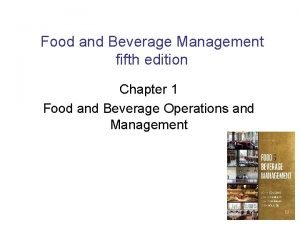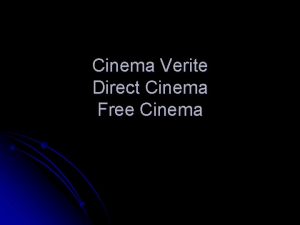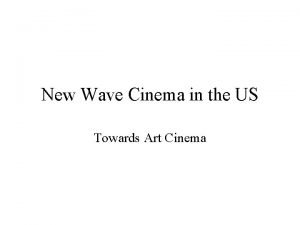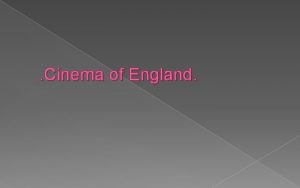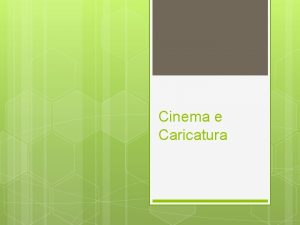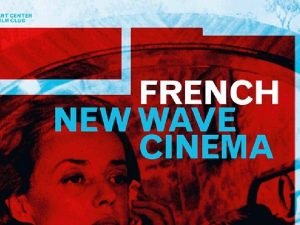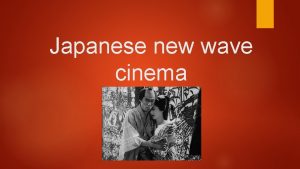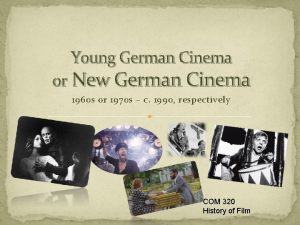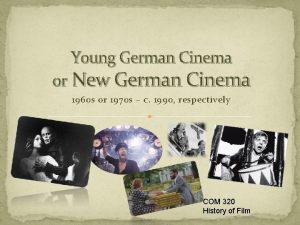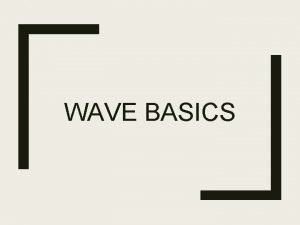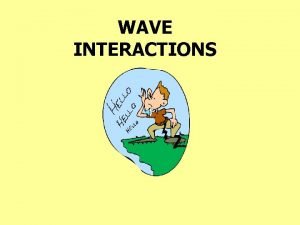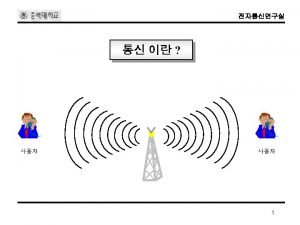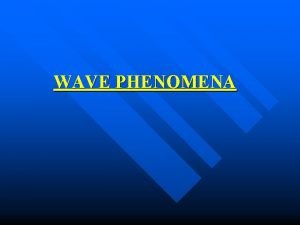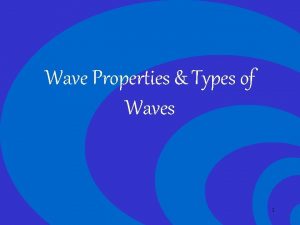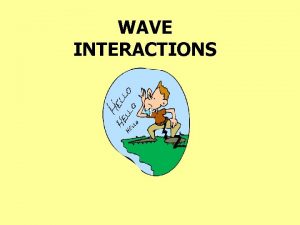New Wave Cinema in the US Towards Art





































- Slides: 37

New Wave Cinema in the US Towards Art Cinema

American New Wave Cinema • Butch Cassidy and the Sundance Kid (1969) - a revisionist Western film by George Roy Hill about two outlaws and their friendship and camaraderie. • Moral ambiguity – utterly lovable criminals and thieves. • Sexual liberation – unconventional love relationship

• Wide screen • Noticeable low angle shots • Ignoring the 180° rule Knife fight

• The shots of a man and a woman on bicycle filmed with zoom lens. While the camera follows the moving people and bicycle, the focus must constantly be adjusted. They come in and go out of focus. (mise-en-scène) • And rugged jump cuts (montage)

Compare this to François Truffaut’s nouvelle vague film, Jules et Jim (1962) She is a vision for all

• Pastel colours – greyish, sepia tone giving scenes nostalgic feel • Close-up in selective focus Card cheating

• Camera positioning – low-level • Actions shot through objects – natural masking • Rapid cutting Final shootout

American New Wave Cinema • Wild Bunch (1969) - Sam Peckinpah’s Western film about American outlaws trying to survive the modern world in the Texas-Mexican borders but die bloody deaths in Mexico.

• Controversial in the representation of violence and the portrayal of cruel and violent men. • Technical expertise in multi-angle editing, rapid cutting and slow-motion photography • Final shootout

• Four outlaws march through the village of Agua Verde to confront the villainous General Mapache. It was shot mainly with a rare telephoto lens giving the scene a distinctive look that made the four visually heroic. The foreground and the background compressed. The walk

• 3, 600 cuts for 137 min. film Shall we gather at the river? • Shots from multiple positions spliced together in rapid succession. • Slow motion – Peckinpah shot action sequences using up to six cameras from the same position, running at different speeds.

New Hollywood Cinema • M*A*S*H (1970) - a satirical comedy on war (the Korean War) by Robert Altman • Anti-establishment humour, episodic narrative and editing, overlapping conversations and sudden zooms

• Episodic storytelling to the limit – no linear flow of narrative • Episodes are filmed mainly in extended takes The Last Supper

• Casual composition • Use of zoom lens – little re-composition and long takes • Sudden zoom A shower with hot lips

New Wave Directors Arthur Penn (1922 - ) Heavily influenced by Nouvelle vague, the maker of The of Bonnie and Clyde Mike Nichols (1931 - ) German Jew, who moved to movies from the stage, the maker of The Graduate

New American Film Directors John Schlesinger (1926 - ) British filmmaker from television, Midnight Cowboy (1969) Peter Bogdanovich (1939 - ), Serbian Jew, nouvelle vague Paper Moon (1973)

New Hollywood and Independent Directors Francis Ford Coppola (1939 - ) Italian American, graduate of UCLA film school, The Conversation (1975) Martin Scorsese (1942 - ) Italian American, graduate of UNY film school, Taxi Driver (1975)

New Hollywood and Independent Directors George Lucas (1944 - ) USC Steven Spielberg (1946 - ) film school graduate, film Attended CSU, Long Beach buff, American Graffiti after failing to enter UCLA (1973) three times, The Sugarland Express (1974)

New American Films John Schlesinger, Midnight Cowboy (1969) • A buddy drama, in which a young Texan comes to NY and becomes to be a male prostitute and meets a Latino con man with a limp. They become soul mates and make a trip to Miami because the Latino is suffering from tuberculosis.

• Close-up and selective focus – expressive mise-enscène First encounter

• Constant use of selective and rack focus Real job

• Constant flashback and flash forward Lose home

• Rapid and elliptic cutting Bus trip

New American Films • Peter Bogdanovich’s Paper Moon (1973) • A road movie in which a con man agrees to deliver an orphan girl from Kansas to her aunt’s home in St. Joseph, Missouri. On their way, the pair earn money by the fraudulent sale of bibles • Shot deliberately in black-and-white

• Consistently shot in wide-angle lens – deep space and deep focus and the foreground distorted. Bible salesman

• Distorted, blown-up images by wide-angle lens I’ve given you 20 dollars

• • New Hollywood Film Directors Graduate of film school or college graduate Film career as director with an independent film. Recognition by Hollywood High budget, high concept film Artistic and financial success Francis Ford Coppola, Martin Scorsese, Steven Spielberg, George Lucas, Brian de Palma, Woody Allen, etc.

• Francis Ford Coppola, Finian’s Raibow (1968) • An Irish-American musical starring Fred Astaire and Petula Clark. An Irish immigrant and his daughter mover into a town in the American south with a magical piece of gold that will change people’s lives, incl. a struggling farmer and African American suffering from racial injustice.

• • • Fantasy More conventional mise-en-scène and montage 141 minutes running time Saturated Technicolor Panavision wide-screen format Departure

• Martin Scorsese, Mean Streets (1973) • A drama about a young Italian- American in NY having a strong sense of responsibility towards his reckless, delinquent friend. Charlie and Johnny Boy

• Shot on location in LA but the film set in NY • Johnny Boy shot in telephoto lens • Charlie shot in wide-angle lens (deep space) and telephoto lens (shallow space). • Garish, raw colours Charlie and Johnny Boy

• Reality effects – to give an impression that the film mimics reality Messy killing of a thug by a hitman • Shot in available red light – not low-key lighting but in available light

• Charlie is intoxicated with alcohol and drug • He sits in a chair and is swung against red light. Rubber biscuit

• Harvey Keitel as Charlie and Robert de Niro as Johnny Boy, Method acting • Realist narrative and realist characterization

The End of New Wave Era • The success of Star Wars (1977) and Close Encounters of the Third Kind (1977) revived Hollywood blockbuster films • The success of Superman (1978) revived the Hollywood tradition of sequels and remakes

The End of New Wave Era • High concept cinema • With concentration on tie-in merchandise (toys) • With spin-offs into other media (books, magazines, television and later video) • With the use of sequels • Cinema is commercialized again • Reflecting economy rather than personal visions of filmmakers

Styles in American New Wave Cinema • More freedom in filmmaking • Renovation of genres • DIVERSE STYLES: more formalist and more experimental • Self-conscious stylists • Personal films
 American new wave cinema
American new wave cinema Japanese new wave
Japanese new wave La vrit
La vrit Third world
Third world The orchard new hartford ny
The orchard new hartford ny No wave films
No wave films 06/11/2011 18:00
06/11/2011 18:00 O thou who art turning thy face towards god
O thou who art turning thy face towards god Sound waves are transverse waves true or false
Sound waves are transverse waves true or false Short wave vs long wave radiation
Short wave vs long wave radiation Difference between full wave and half wave rectifier
Difference between full wave and half wave rectifier Transverse and longitudnal waves
Transverse and longitudnal waves Half full wave rectifier
Half full wave rectifier Bridge type full wave rectifier
Bridge type full wave rectifier P and s wave arrival time chart
P and s wave arrival time chart Full wave rectified sine wave fourier series
Full wave rectified sine wave fourier series Nature of sound wave
Nature of sound wave The nature of waves chapter 10 section 1
The nature of waves chapter 10 section 1 Full wave symmetry
Full wave symmetry What do all waves transmit
What do all waves transmit Characteristics of mechanical waves
Characteristics of mechanical waves Wavelength formula triangle
Wavelength formula triangle Balance in art
Balance in art Architect's home in the ravine
Architect's home in the ravine New wave design movement
New wave design movement Ability of two or more waves to combine and form a new wave
Ability of two or more waves to combine and form a new wave Reed supermarkets
Reed supermarkets Punk musik merkmale
Punk musik merkmale Realism, french new wave
Realism, french new wave Kotryna parr
Kotryna parr The four realms of experience
The four realms of experience New wave immigrants
New wave immigrants Belmondo osu
Belmondo osu Hình ảnh bộ gõ cơ thể búng tay
Hình ảnh bộ gõ cơ thể búng tay Lp html
Lp html Bổ thể
Bổ thể Tỉ lệ cơ thể trẻ em
Tỉ lệ cơ thể trẻ em Chó sói
Chó sói
